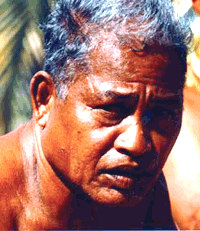Caroline Islands
Caroline Islands are a sprawling archipelago in the western Pacific Ocean, located to the northeast of New Guinea and south of the Mariana Islands. This group of islands is part of Micronesia, a region that consists of hundreds of small islands divided into eight territories. The Caroline Islands themselves are divided politically between the Federated States of Micronesia (FSM) in the eastern part of the archipelago, and Palau at the western end.
History[edit | edit source]
The history of the Caroline Islands is marked by a rich cultural heritage and a complex colonial past. Originally settled by Austronesian people who navigated the Pacific Ocean using traditional stick charts, these islands have seen influence from various European powers. The Spanish were the first Europeans to claim the islands in the 16th century, naming them after King Charles II of Spain. In the late 19th century, control of the islands was sold to Germany, marking the beginning of German colonial rule. After World War I, the islands were administered by Japan under a League of Nations mandate. Following World War II, they came under United States administration before achieving independence, with Palau and the FSM becoming sovereign states in 1994 and 1986, respectively.
Geography[edit | edit source]
The Caroline Islands cover a vast area of the Pacific Ocean and include both high volcanic islands and low coral atolls. The geography of the islands varies significantly from one island to another, with some featuring rugged terrain and others offering flat, sandy landscapes. The climate is tropical, with a rainy season and a dry season. The islands are home to diverse ecosystems, including mangroves, rainforests, and coral reefs, which support a wide range of flora and fauna.
Culture[edit | edit source]
The cultures of the Caroline Islands are diverse, with each island group having its own languages, traditions, and social structures. Traditional navigation and canoe-building are among the most celebrated aspects of Caroline Islands culture, reflecting the importance of the sea in daily life. Other cultural elements include matrilineal social organization, traditional dance, and the production of woven and carved artifacts. Despite the impact of colonialism and modernization, many of these traditions remain vibrant and are integral to the islands' identities.
Economy[edit | edit source]
The economy of the Caroline Islands is primarily based on subsistence agriculture, fishing, and tourism. Staple crops include taro, yams, and breadfruit, while copra (dried coconut meat) and fish are important for both local consumption and export. Tourism is growing, with visitors drawn to the islands' natural beauty, including their pristine beaches, diving sites, and cultural festivals. However, the remoteness of the islands and their vulnerability to natural disasters pose challenges to economic development.
Environmental Concerns[edit | edit source]
The Caroline Islands face several environmental challenges, including climate change, deforestation, and overfishing. Rising sea levels and increased frequency of storms threaten low-lying atolls, while unsustainable land use practices and overfishing pose risks to biodiversity and food security. Conservation efforts are underway to address these issues, focusing on sustainable development, protection of marine areas, and climate change adaptation strategies.
Search WikiMD
Ad.Tired of being Overweight? Try W8MD's physician weight loss program.
Semaglutide (Ozempic / Wegovy and Tirzepatide (Mounjaro / Zepbound) available.
Advertise on WikiMD
|
WikiMD's Wellness Encyclopedia |
| Let Food Be Thy Medicine Medicine Thy Food - Hippocrates |
Translate this page: - East Asian
中文,
日本,
한국어,
South Asian
हिन्दी,
தமிழ்,
తెలుగు,
Urdu,
ಕನ್ನಡ,
Southeast Asian
Indonesian,
Vietnamese,
Thai,
မြန်မာဘာသာ,
বাংলা
European
español,
Deutsch,
français,
Greek,
português do Brasil,
polski,
română,
русский,
Nederlands,
norsk,
svenska,
suomi,
Italian
Middle Eastern & African
عربى,
Turkish,
Persian,
Hebrew,
Afrikaans,
isiZulu,
Kiswahili,
Other
Bulgarian,
Hungarian,
Czech,
Swedish,
മലയാളം,
मराठी,
ਪੰਜਾਬੀ,
ગુજરાતી,
Portuguese,
Ukrainian
Medical Disclaimer: WikiMD is not a substitute for professional medical advice. The information on WikiMD is provided as an information resource only, may be incorrect, outdated or misleading, and is not to be used or relied on for any diagnostic or treatment purposes. Please consult your health care provider before making any healthcare decisions or for guidance about a specific medical condition. WikiMD expressly disclaims responsibility, and shall have no liability, for any damages, loss, injury, or liability whatsoever suffered as a result of your reliance on the information contained in this site. By visiting this site you agree to the foregoing terms and conditions, which may from time to time be changed or supplemented by WikiMD. If you do not agree to the foregoing terms and conditions, you should not enter or use this site. See full disclaimer.
Credits:Most images are courtesy of Wikimedia commons, and templates, categories Wikipedia, licensed under CC BY SA or similar.
Contributors: Prab R. Tumpati, MD




